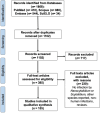A Systematic Review on the Emerging Fungal Pathogen Neoscytalidium Causing Infections Worldwide
- PMID: 40618306
- PMCID: PMC12229967
- DOI: 10.1007/s11046-025-00964-4
A Systematic Review on the Emerging Fungal Pathogen Neoscytalidium Causing Infections Worldwide
Abstract
Scytalidiosis is a dermatomycosis caused by fungi of the genus Neoscytalidium. An increase in the number of cases at the global level has been reported. In the present study, the clinical characteristics of patients diagnosed with scytalidiosis were analyzed through a systematic review of cases reported in the literature. An advanced search was conducted through four databases: MEDLINE/PubMed, SCOPUS, Embase, and SciELO using the terms "Neoscytalidium" or "Scytalidium". A total of 155 reports with 5,097 cases were analyzed of which 30.12% were women and 27.31% were men. A total of 37 countries reported cases of scytalidiosis. The USA, Thailand, France, Brazil, Colombia, and the UK had the highest number of cases. The most prevalent species were N. dimidiatum (38.96%) and N. hyalinum (7.47%). One case of N. oculus sp. nov. and seven instances of N. novaehollandiae were also reported. Regarding the clinical presentation, 68.30% of patients had onychomycosis, 5.93% had skin infections, and 24.16% presented both types of infections. Other less frequent presentations (1.61%), including keratitis/endophthalmitis, CNS infection, invasive or disseminated infection, sinusitis/rhinosinusitis, mycetoma, endocarditis, and dyskeratosis were also reported. This review shows that the epidemiology of scytalidiosis is changing, other regions that had not been considered endemic are now reporting the highest number of cases. Neoscytalidium spp. should be considered an important emerging pathogen and the main non-dermatophyte fungus causing onychomycosis and skin infections after dermatophytes. Likewise, other clinical presentations caused by this fungal pathogen should not be underestimated, especially in patients with some immunocompromise or underlying disease.
Keywords: Neoscytalidium; Neoscytalidium dimidiatum; Neoscytalidium hyalinum; Scytalidium; Dermatomycosis; Onychomycosis.
© 2025. The Author(s).
Conflict of interest statement
Declarations. Conflict of interest: The authors declare no conflict of interest.
Figures



Similar articles
-
[Volume and health outcomes: evidence from systematic reviews and from evaluation of Italian hospital data].Epidemiol Prev. 2013 Mar-Jun;37(2-3 Suppl 2):1-100. Epidemiol Prev. 2013. PMID: 23851286 Italian.
-
Systemic pharmacological treatments for chronic plaque psoriasis: a network meta-analysis.Cochrane Database Syst Rev. 2017 Dec 22;12(12):CD011535. doi: 10.1002/14651858.CD011535.pub2. Cochrane Database Syst Rev. 2017. Update in: Cochrane Database Syst Rev. 2020 Jan 9;1:CD011535. doi: 10.1002/14651858.CD011535.pub3. PMID: 29271481 Free PMC article. Updated.
-
Systemic pharmacological treatments for chronic plaque psoriasis: a network meta-analysis.Cochrane Database Syst Rev. 2021 Apr 19;4(4):CD011535. doi: 10.1002/14651858.CD011535.pub4. Cochrane Database Syst Rev. 2021. Update in: Cochrane Database Syst Rev. 2022 May 23;5:CD011535. doi: 10.1002/14651858.CD011535.pub5. PMID: 33871055 Free PMC article. Updated.
-
A rapid and systematic review of the clinical effectiveness and cost-effectiveness of topotecan for ovarian cancer.Health Technol Assess. 2001;5(28):1-110. doi: 10.3310/hta5280. Health Technol Assess. 2001. PMID: 11701100
-
Systemic pharmacological treatments for chronic plaque psoriasis: a network meta-analysis.Cochrane Database Syst Rev. 2020 Jan 9;1(1):CD011535. doi: 10.1002/14651858.CD011535.pub3. Cochrane Database Syst Rev. 2020. Update in: Cochrane Database Syst Rev. 2021 Apr 19;4:CD011535. doi: 10.1002/14651858.CD011535.pub4. PMID: 31917873 Free PMC article. Updated.
References
-
- Calvillo-Medina RP, Martínez-Neria M, Mena-Portales J, Barba-Escoto L, Raymundo T, Campos-Guillén J, Jones GH, Reyes-Grajeda JP, González-Y-Merchand JA, Bautista-de Lucio VM. Identification and biofilm development by a new fungal keratitis aetiologic agent. Mycoses. 2019;62(1):62–72. 10.1111/myc.12849. - PubMed
-
- Machouart M, Menir P, Helenon R, Quist D, Desbois N. Scytalidium and scytalidiosis: what’s new in 2012? J Mycol Med. 2013;23:40–6. 10.1016/j.mycmed.2013.01.002. - PubMed
-
- Tonani L, Morosini NS, Dantas de Menezes H, Bonifácio N, da Silva ME, Wainwright M, Leite Braga GÚ, von Zeska R, Kress M. In vitro susceptibilities of Neoscytalidium spp. sequence types to antifungal agents and antimicrobial photodynamic treatment with phenothiazinium photosensitizers. Fungal Biol. 2018;122(6):436–48. 10.1016/j.funbio.2017.08.009. - PubMed
Publication types
MeSH terms
LinkOut - more resources
Full Text Sources
Miscellaneous

